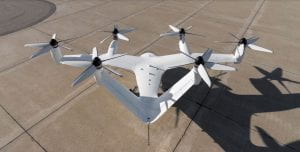
Excitement is growing within the aviation community as improvements in battery technologies offer the potential for dramatically lower operating costs for new classes of electric propulsion aircraft. By reducing aircraft operating costs by as much as 30%, electric propulsion could transform both air and surface transportation [1]. The term “on-demand mobility” (ODM) has been interpreted in an aviation context as an air service between origin-destination pairs located at dispersed locations – not necessarily airports – that operates in an unscheduled (“on-demand”) paradigm; when called by a user, typically via a smartphone app, an aircraft is dispatched to the nearest departure origin. There is now widespread belief that ODM missions could be served by small electric propulsion aircraft with vertical take-off-and-landing (VTOL) capabilities that operate from vertiports or similar infrastructure. These electric-VTOL (eVTOL) aircraft could provide air-taxi service for trips of two to four passengers between 10 to 70 miles within congested urban areas [2]. Dozens of companies have publicly-acknowledged designing eVTOL aircraft including Airbus, Embraer, Joby Aviation, Aurora Flight Sciences, and Pipistrel.
Dr. Garrow’s research group has investigated several topics related to predicting demand for air taxi service. In one project, we conducted a survey of 2,500 high-income workers who reside and work in the Atlanta, Boston, Dallas-Ft. Worth, San Francisco Bay Area, or Los Angeles combined statistical areas (CSAs). The survey targeted individuals with average one-way commutes of 30 minutes or more and included a question that allowed us to model modal competition among a traditional auto, transit, and air taxi. We used the results of the survey to understand commuters’ willingness to fly and willingness to pay for air taxi service for commuting.
In a subsequent project, we used the mode choice models from the surveys described above along with cell phone and census data to map where commuters live and work and to identify potential commuter air taxi routes in the 40 largest cities in the U.S. Results show that commuter air taxi demand is concentrated in a handful of cities, with 33% of demand occurring in the New York, Los Angeles, and Washington, DC metro areas. Multiple factors contribute to demand including the morphology of the city and current placement of take off and landing areas. Click here for information about the project.
Finally, as part of ongoing work, we conduct a meta-analysis of about 800 articles in the urban air mobility, electric ground vehicle, and autonomous ground vehicle areas that have been published from January 2015 to June 2020 in order to compare and contrast research thrusts. Alongside this effort, we conduct an in-depth review of articles related to demand modeling, operations, and integration with existing infrastructure. We used insights from the meta-analysis and comprehensive review to inform future UAM research directions. Click here for paper.
Key publications related to this work:
[1] Boddapalli, S.-S., Garrow, L.A., and German, B.J. (2020). Mode choice analysis for an electric vertical take-off and landing air taxi commuting service in five large U.S. cities. Working paper, Georgia Institute of Technology. .
[2] Garrow, L.A., German, B.J., and Leonard, C.E. (2021). Urban air mobility: A comprehensive review and comparative analysis with autonomous and electric ground transportation for informing future research. Transportation Research Part C 132: 103377. Click here for paper..
[3] Haan, J., Garrow, L.A., Marzuoli, A., Roy, S., and Bierlaire M. (2021). Are commuter air taxis coming to your city? A ranking of 40 cities in the United States. Transportation Research Part C 132: 103392. Click here for paper and visit our website with interactive maps for the 40 cities here.
References:
[1] Moore, M.D. (2012). Distributed electric propulsion (DEP) aircraft. Presentation available at https://aero.larc.nasa.gov/files/2012/11/Distributed-Electric-Propulsion…. Accessed July 19, 2017.
[2] Badalamenti, J. and Peterson, J. (2017). City optimization tech talk. Presentation at the Uber Elevate Summit, Dallas, TX. Accessed July 19, 2017.
